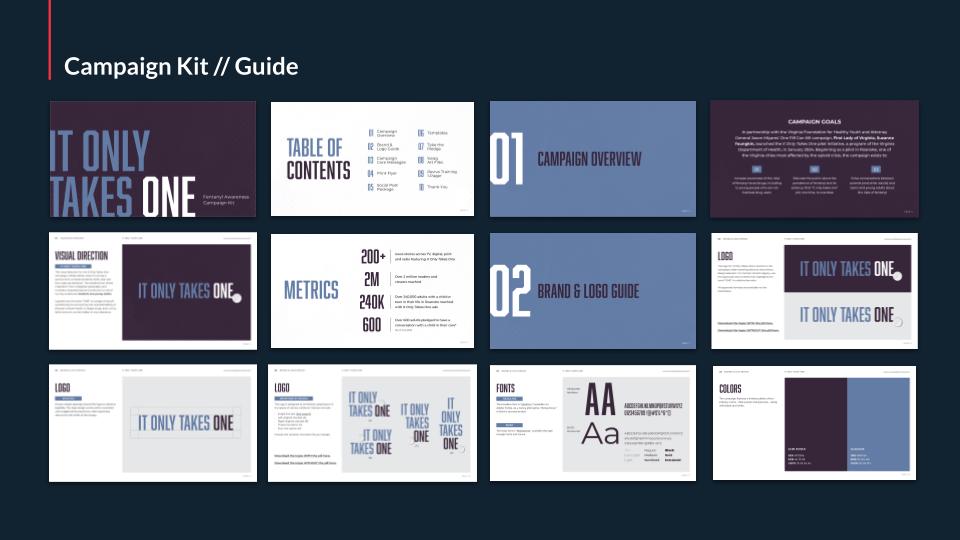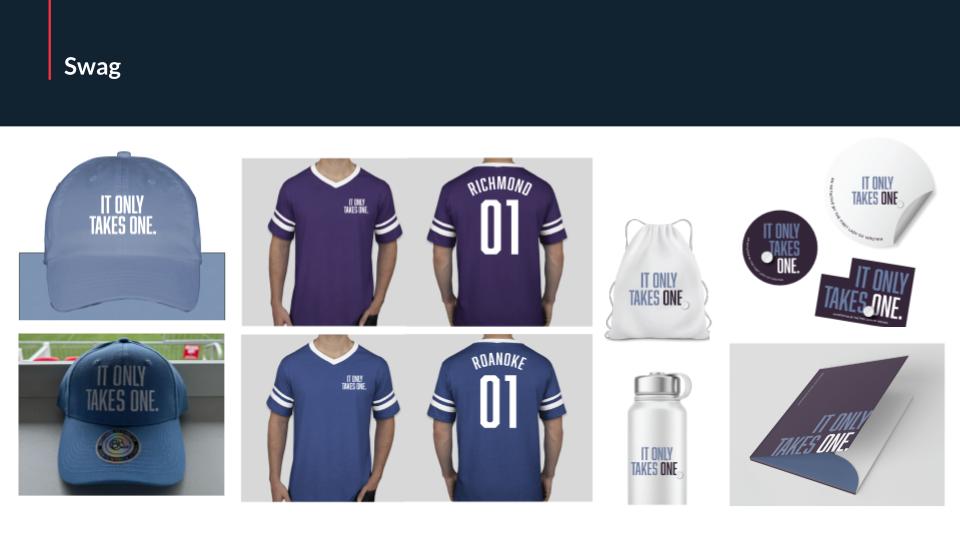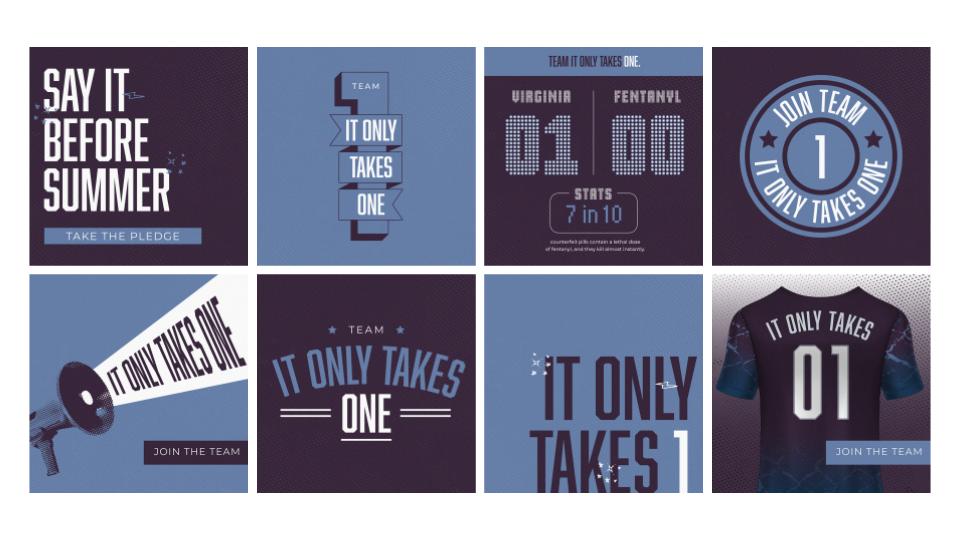First lady of virginia
Integrated communications to make a real-world impact on fentanyl crisis
WHAT WE DID
Research
Campaign Development
Earned Media
Creative Direction
Social Media
Visual Identity
The Challenge
Fatal overdoses due to fentanyl have become a devastating problem for the Commonwealth of Virginia, killing approximately five Virginians per day.
First Lady of Virginia Suzanne Youngkin approached Pinkston with a desire to leverage her platform to unify the various narratives, initiatives and leaders across Virginia that were working to address the issue, included the Virginia Foundation for Healthy Youth (VFHY), Virginia’s Secretary of Health and Human Resources, and the Virginia Attorney General. In combining efforts, the First Lady sought to help these stakeholders drive greater impact.
Specifically, Pinkston was tasked with creating a new unifying campaign and launching a pilot outreach and awareness campaign in a target area of Virginia, with a focus on parents and trusted adults with a teen in their sphere of influence. The campaign was intended to serve as a model for additional efforts throughout Virginia and across the country. To stand up and execute this campaign, Pinkston provided a broad array of support, including strategic planning and research, creative and collateral development, paid digital advertising, public relations, campaign measurement and more.
Research & Creative Approach
Pinkston applied multiple kinds of research findings to shape the campaign core concept, branding and messaging framework, which informed the website and channel strategy approach.
Once the location for the pilot program was chosen – Roanoke, an area with a high incidence of fentanyl overdose – Pinkston launched several research instruments. This included conducting surveys to establish baseline measurements of the public’s awareness and sense of urgency on the issue, interviewing parents to explore reactions to creative campaign concepts and messaging, and parsing pre-existing research commissioned by VFHY and state public health data. Pinkston also hosted meetings with a number of Virginians who had lost loved ones to fentanyl overdose, battled addiction themselves, or even dealt the drug.
Pinkston’s creative approach was further shaped by audience refinement. While the primary goal was to curb overdoses in young people by increasing awareness, it became clear that the scope of the overdose problem was not limited to habitual users or addicts — and that reaching parents of non-habitual users offered a high-potential area of impact for the campaign. With that audience segment in mind, Pinkston identified key decision points that could lead to a young person taking a fentanyl-laced substance for the first time: e.g., an injured high school athlete whose pain medications ran out, a stressed student needing to relax before a test, or a partygoer just looking to have fun. We also built out a narrative and messaging platform that emphasized the extremely high risks of fentanyl contamination in illicit drugs, outlining the urgency of the problem and the relevance to any young person.
Additional important creative considerations included integrating recognizable local (Roanoke) visual motifs into ad visuals. Cognizant of the many sensitivities surrounding the issue and the risk of off-putting caricatures, Pinkston guarded carefully against visual concepts that might inadvertently alienate an affected community and render the outreach campaign less impactful. We also thoroughly analyzed the existing landscape of PSAs and drug-related outreach campaigns to determine how our campaign might imitate, complement or stand out from communications concepts the public had already seen.
The consistent visual motif that emerged was that of a single white pill or clump of powder. This motif stretched across two core ad concepts:
1. “It’s Not the Same Without You” — focusing on the hole left behind by each death due to fentanyl.

2. “I Was Just Trying To…” — Converting a relatable refrain for young people into an educational tool for parents.




Outreach
Pinkston executed a comprehensive outreach campaign consisting of a major launch event, earned media, op-eds, digital ads and out-of-home advertisements such as flyers and billboards. Throughout the outreach phase, we provided consultative support to help shape the launch event, including: conducting a venue walkthrough, vetting and preparing spokespeople, generating and managing media attendance and more.
Across the six week pilot phase, Pinkston secured nearly 200 media placements, including an op-ed co-written by the First Lady and Virginia Attorney General that ran on the same day as the campaign launch. This media coverage was focused in Roanoke, but also extended to media markets across the Commonwealth, including Richmond and Virginia Beach.
Launching concurrently with the in-person event, Pinkston began a multi-faceted digital ad campaign, targeting adults across social, search, programmatic, outdoor and other platforms. The campaign exceeded benchmarks and ultimately reached the entire addressable adult population in Roanoke over 20 times with ad creative – achieving 150% of desired saturation. Of the 40,890 people who visited the website, 82% arrived there because of paid ads. Across multiple creative executions, the “I Was Just Trying To” concepts performed the strongest with parents and across all sub audiences.
Results
After the campaign had reached market saturation, Pinkston conducted a follow-up survey to determine changes in the audience’s awareness, level of urgency or motivation and any actions taken related to the campaign’s calls to action.
Of the target audience who was exposed to the campaign in this window, we saw an increased awareness of the following information: 1) that anyone can be impacted by fentanyl use or overdose, 2) where fentanyl can be found and 3) that it only takes one pill to overdose. Those who saw the campaign indicated an increased likelihood of having a conversation about fentanyl risks.
65% of Adults surveyed saw one or more ads or news stories from the campaign.

The primary opportunity we observed was in the reported number of total respondents who had actually had a conversation about fentanyl, indicating a continuing need in messaging and opportunities for the target audience to engage with the issues. Additionally, there remains work to be done to reduce the stigma around kids who take drugs.
In an age of pervasive noise, a sustained and integrated strategy was needed to break through to an audience. Deploying complementary messages and creative executions through multiple connected channels significantly increased the likelihood of awareness, recall and intention to act, which is essential to any public health campaign – but especially one where lives are at stake every day.